Caste distinction in Indian indenture: pride and prejudice
Folk religion
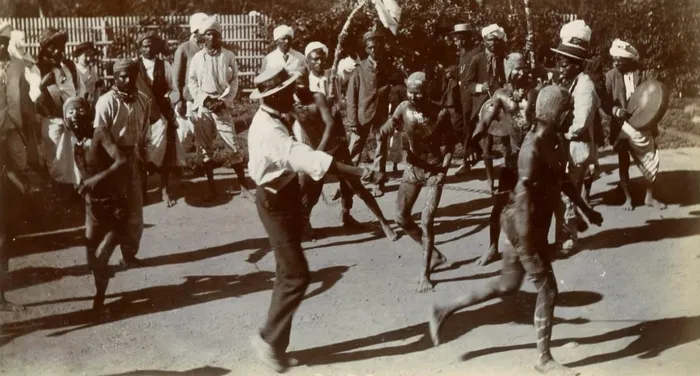
Indentured workers of different religions perform in the Muhurram Procession in Tongaat, 1908.
Image: 1860 Heritage Centre
THE report of the Protector of Immigrants for the year 1886 reported that there were 185 marriages registered in the Colony of Natal, with only 13 having been between Indians who arrived during that year.
The report highlighted an extraordinary case that was investigated during the year, in which an indentured Indian, “a Hindoo of Ahir caste, who became enamoured with a young girl who is a Mahommedan”.
The relatives of the girl would not consent to a marriage between them, although it seemed as though an illicit connection had long been established. The man pursued the girl for some time without any success. Eventually, he committed suicide by hanging himself, as he had threatened to do, when the girl's relatives repeatedly declined to allow the marriage.
From the first indentured workers who arrived in South Africa on board the SS Truro on November 16, 1860, to the last manifest of the SS Umlazi in 1911, matters of caste distinction danced in a range of roles on the foreign stage of a new homeland. Many examples of caste distinctions are made clear through the colonial archive and other sources, like the well-illustrated, A Documentary History of Indian South Africans, edited by Surendra Bhana and Bridglal Pachai, as well as exceptional field research conducted by the seminal studies of Hilda Kuper and Professor Fatima Meer.
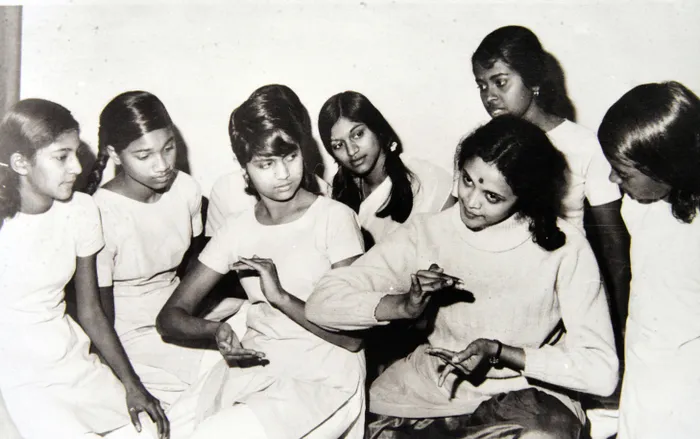
Young women from the Hindi, Gujarati, and Tamil communities living in central Town learn the art of Bharatanatyam in the 1970s. They are, from left, Dr Chitralekha Naidoo, Krishnaveni Naicker, the only Gujarati Bharata Natyam student among Tamils, Professor Uma Dhupelia, Professor Suria Govender, Baby Pillay Saloshini Govender and Jayalakshmi Naidoo (now Chandrasekar).
Image: 1860 Heritage Centre
In an insightful case of caste prejudice, first cited by Bhana and Pachai, submerged in the colonial archive repository at Pietermaritzburg, is an enthralling case of the community of Umzinto requesting the removal of two constables placed in their division because of their low caste status as pariyans.
In a petition dated May 3, 1909, addressed to the Protector of Indian Immigrants, the community writes: “We, the undersigned Indians, residing in the Alexandra Division, wish to bring the following grievance to notice. There are two Indians here of the Pariah caste named Anjuru and Munsamy, brothers, who are appointed as constables.
"These constables harass Hindus in many ways. Amongst others, they require Hindus to salute them. This, Sir, you are well aware, would not be tolerated in India… We have six other Constables here, but they are not of Pariah Caste and do not harass us at all, although they have been in service a long time… As 9/10ths of the Indians in this division are above the Pariah Caste, we hope you (the Protector) will take such steps on our behalf as to procure the immediate dismissal of these constables… " - Signed, Your Obedient Sevants.
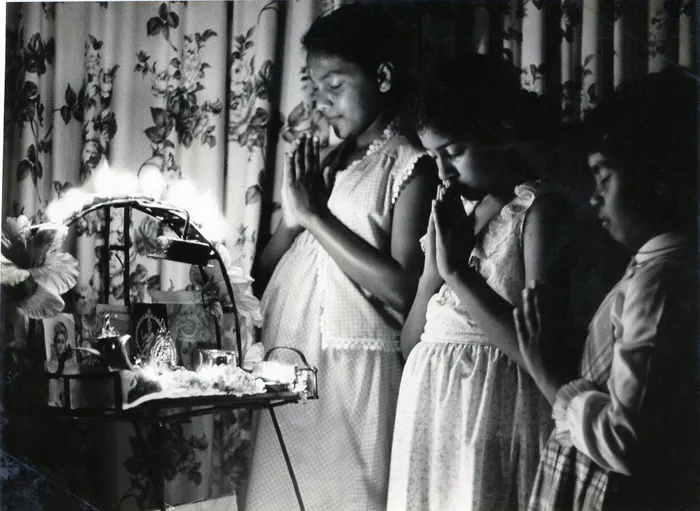
Girls of different caste pray during Diwali.
Image: The Leader Collection Housed at the 1860 Heritage Centre
In South Africa, the 152 184 indentured workers who arrived in Natal were forced to rebuild their lives without most of the familiar institutions or caste impositions that surrounded them in India. While Hinduism remained the religion of the majority in colonial Natal, it lacked the Sanskrit validation of the ancient Indian traditions.
Here, the main elements of village rituals were remembered and fostered on the plantations where the indentured worked. Kuladaivam traditions of local village deities were central to the lives of the indentured villagers. Their local gods and goddesses, whose worship formed much of the folk traditions, were brought with many of the indentured workers to South Africa.
As more and more indentured workers arrived in South Africa, and while folk beliefs common to village India continued on the plantations, the enforced move to the suburbs of urban areas radically altered the lives of indentured Indians. Patterns of hierarchy, of perceived purity and impurity, of caste distinctions and group belonging could no longer be maintained in an alien and often hostile colonial environment. The new world of the indentured, in the majority, removed caste restrictions that they experienced when they crossed the kala pani (black Indian Ocean waters).
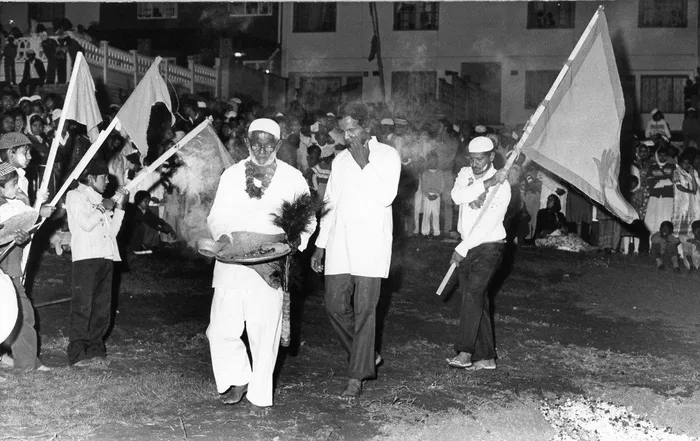
Members from the Muslim community in a fire walking procession in Phoenix, 1980s.
Image: The Leader Collection Housed at the 1860 Heritage Centre
It may pain many to know that in colonial Natal, the dominant caste arriving from Madras was the Paraiyar. The dominant caste among those from Calcutta was the Chamar. Christian Indians came mostly from Madras, where two-thirds of the three million Christian population of India resided in the 1900s. The jahaji-bhens and bhais, for the most part, shook off those caste straitjackets.
Between 1860 and 1866, Christians constituted 5.5% of the Indian population of Natal. As indenture continued, this proportion dropped significantly, with Christians only constituting 1.3% of the total of 152 184 indentured pool by 1911. Muslims made up 3% of the working people. Among these, names like Sheik, Mahomed, Syed, and Abdool dominate the statistical data.
Noted historian, Professor Goolam Vahed, writing on Constructions of Community and Identity among Indians in Colonial Natal, 1860-1910, records that: “Despite the difficulties of indenture, Indians set about re-establishing their culture and religion in Durban. The most visible and public expression of ritual was the festival of Muhurram, which played an important role in forging a pan-Indian identity within a white and African colonial society.”
Professor Gerald Pillay’s seminal study of the Bethesda Temple among Indian Africans reveals that on board the first indenture ship were 65 Christians.
Pillay relates that a French Catholic priest, Jean-Baptiste Sabon, met many of the arrivals. Sabon was well-suited to the pastoral care of indentured Indians as he was fluent in Tamil. Father Sabon wrote: “Though Indians are not perfect – far from it - there are many among them who are more zealous than many other Christians elsewhere.”
Despite the ship brother traditions of the indentured descendants, it has not always been one-way traffic. Caste distinctions periodically reared its ugly head, even with the threat of death in full view. In 1949, at the time of the Cato Manor race riots, archivist of the Shree Emperumal Temple in Mount Edgecombe, Sunny Pillay, narrates the story of his father, indentured worker Appavoo Pillay, who arrived from Trichinopoly in 1907, refusing to move to a house of safety because it belonged to people of a lower caste.
Appavoo Pillay exclaimed in Tamil, “Nāṉ iṟantāl, eṉ vīṭṭilēyē iṟappēṉ, tāḻnta cātiyiṉariṉ vīṭṭil all - if I die, I will die in my house, not in the home of a low caste!”
Despite the examples cited, many outliving reformist propagation, for the majority of indentured and their descendants in Natal, casteless folk village traditions remain as the dominant practice in their African homes.
Kavady, Marriamman, Muhurram, Ta’zieh processions with tiger dances, the Natchania (sung in the Bhojpuri dialect), Therukoothu (South Indian dance that included six-foot dance), and Sufi qawwalis, all traditional practices that once dominated our cultural landscape, are slowly being revived by our youth. It is gratifying to see a revival of these practices with our youth, picking up observances like Raam bhajans, Muhurram, Kavady, Thimidhi, and Nagara performances with greater devotion and gusto.
While all of the indenture history is valuable, the future being shaped by our young people in all spheres of endeavour looks far more promising than the caste-tainted observances we see stealthily creeping into our society every now and then.
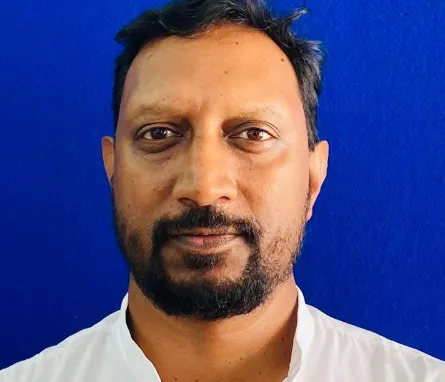
Selvan Naidoo
Image: File
Selvan Naidoo is the great-grandson of Camachee Camachee, number 3297, and director of the 1860 Heritage Centre.
Related Topics: